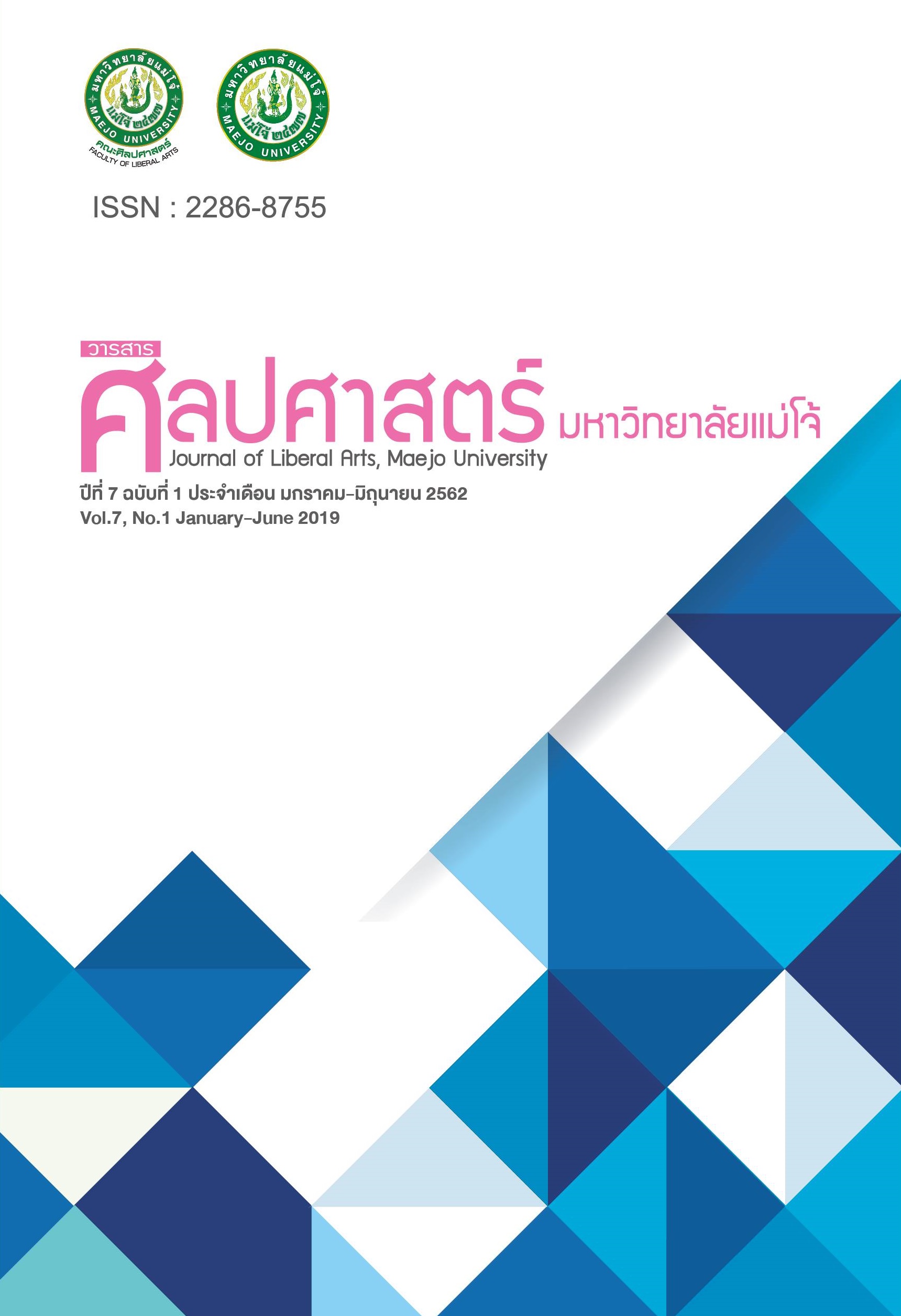อิทธิพลของบทบรรยายในสื่อโสตทัศน์ต่อการเรียนภาษาอังกฤษ
Main Article Content
บทคัดย่อ
บทความนี้มีวัตถุประสงค์เพื่อศึกษาอิทธิพลของบทบรรยายที่ปรากฏในสื่อโสตทัศน์ต่อการเรียนภาษาอังกฤษ สื่อโสตทัศน์ เช่น ภาพยนตร์และรายการโทรทัศน์มีบทบาทสำคัญต่อผู้ชมในแง่ของการให้ข้อมูลข่าวสารและความบันเทิง ในปัจจุบัน สื่อโสตทัศน์เป็นหนึ่งในเครื่องมือในการเรียนภาษาอังกฤษที่มีประสิทธิภาพ เนื่องจากผู้เรียนสามารถเข้าถึงสื่อประเภทนี้ได้ง่าย อีกทั้งยังสามารถจูงใจและกระตุ้นความสนใจผู้เรียนได้อีกด้วย นอกจากนี้ สื่อประเภทนี้ยังมีองค์ประกอบที่สำคัญ คือ บทบรรยาย ที่ผู้ชมสามารถเลือกเปิด ปิด หรือเลือกภาษาที่ต้องการขณะรับชมภาพยนตร์และรายการได้ จากการทบทวนวรรณกรรมที่เกี่ยวข้องทั้งในและต่างประเทศ พบว่า บทบรรยายในสื่อโสตทัศน์มีประโยชน์ต่อการเรียนภาษาภาษาอังกฤษโดยช่วยให้ผู้เรียนจดจำคำศัพท์ ลักษณะการใช้ภาษา รวมถึงสามารถพัฒนาทักษะการฟังและการอ่านของผู้ชมได้ ซึ่งสามารถอธิบายได้โดยทฤษฎีรหัสคู่ กล่าวคือ การรับข้อมูล (ภาษาอังกฤษ) ทั้งภาพและเสียงประกอบกันจะทำให้ผู้เรียนจดจำและเข้าใจข้อมูลนั้นๆ ได้ดีกว่าการรับข้อมูลช่องทางเดียว (ภาพหรือเสียง) ดังนั้น เมื่อผู้เรียนชมภาพยนตร์หรือรายการโทรทัศน์ภาษาอังกฤษพร้อมอ่านบทบรรยายไปด้วย ผู้เรียนจะสามารถจดจำคำศัพท์และรูปแบบประโยคได้ดีขึ้นเนื่องจากผู้เรียนได้ยินเสียงภาษาอังกฤษและเห็นบทบรรยายในเวลาเดียวกัน
Article Details
เอกสารอ้างอิง
Bird, S. & William, J. N. (2002). The Effect of Bimodal Input on Implicit and Explicit Memory: An Investigation of Within-Language Subtitling. Applied Psycholinguistics. 23(4), 509-533.
Birulés, M. J. & Soto, F. S. (2016). Watching Subtitled Films Can Help Learning Foreign Langiages. PLoS ONE, 11(6). Retrieved November 20, 2018, from https://doi.org/10.1371/journal.pone. 0158409
Borrás, I. & Lafayette, R. C. (1994). Effect of multimedia courseware subtitling on the speaking performance of college students of French. Modern Language Journal. 78, 61-75.
Chang, A. (2009). The effect of reading while listening to audiobooks: Listening fluency and vocabulary gain. Asian Journal of English Language Teaching. 21, 43-64.
Chang, A. & Read, J. (2006). The effects of listening support on the listening performance of EFL learners. TESOL Quarterly. 40(2), 375-397.
Chapakiya, R. and Laohawiriyanon, C. (2017). The Effect of Using Listening while Reading and Listening Only Techniques on High School Students’ listening ability. Journal of Liberal Arts, Prince of Songkla University, Hat Yai Campus. 9(2), 57-87.
Danan, M. (2004). Captioning and Subtitling: Undervalued Language Learning Strategies. Meta. 49(1), 67-77.
Díaz-Cintas, J. (2006). Audiovisual translation in the Third Millennium. In Translation Today: Trends and Perspectives. (192-204). Beijing: Foreign Language Teaching and Research Press.
Díaz-Cintas, J. & Anderman, G. (2009). Audiovisual Translation: Language Transfer on Screen. Basingstoke: Palgrave Macmillan.
d’Ydewalle, G. & Gielen, I. (1992). Attention allocation with overlapping sound, image, and text. In Eye Movements and Visual Cognition: Scene Perception and Reading. (414-427). New York: Springer-Verlag.
d’Ydewalle, G. & Pavakanum, U. (1992). Watching foreign television programs and language learning. In Cognitive Modelling and interactive environments in language learning. (193-198). Berlin: Springer-Verlag.
Ebrahimi, Y. and Bazaee, P. (2016). The Effect of Watching English Movies with Standard Subtitles on EFL Learners. Content and Vocabulary Comprehension. Journal of Applied Linguistics and Language Research. 3, 284-295.
Garza, T. J. (1991). Evaluating the Use of Captioned Video Materials in Advanced Foreign Language Learning. Foreign Language Annals. 24(3), 239-258.
Goh, C. (1999). How much do learners know about the factors that influence their listening comprehension? Hong Kong Journal of Applied Linguistics. 4(1), 17-42.
Goldman, M. (1993). Using Captioned TV for teaching Reading Fastback. Chicago: Phi Delta Kappa Educational Foundation.
Gottlieb, H. (1997). Subtitles, Translation & Idioms (Doctoral dissertation). Copenhagen: University of Copenhagen.
Guichon, N. & McLornan, S. (2008). The effects of multimodality on L2 learners: Implications for CALL resource design. System. An International Journal of Educational Technology and Applied Linguistics. 36(1), 85-93.
Harji, M. B., Woods, P. C. & Alavi, Z. K. (2010). The Effect of Viewing Subtitled Videos on Vocabulary
Learning. Journal of College Teaching & Learning. 7(9), 37-42.
Hayati, A. & Mohmed, Fi. (2009). The Effect of Films with and without Subtitles on Listening Comprehension of EFL Learners. British Journal of Educational Technology. 42(1), 181-192.
Hofmeister, A., Menlove, M. & Thorkildsen, R. (1992). Learner Diversity and Instructional Video: Implications for Developers. Educational Technology. 32(7). 13-16.
Huang, H. & Eskey, D. (2000). The effects of closed-captioned television on the listening comprehension of Intermediate English as a Second (ESL) students. Journal of Educational Technology Systems. 1, 75-96.
Kikuchi, T. (1997). A Review of research on the education use of English captioned materials in Japan. Memoirs of Numazu College of Technology. 32, 147-160.
King, J. (2002). Using DVD feature films in the EFL classroom. Computer Assisted Language Learning. 15 (5), 509-523.
Koolstra, C. M. & Beentjes, W. J. (1999). Children’s vocabulary acquisition in a foreign language through watching subtitled television programs at home. Educational Technology Research & Development. 47, 51-60.
Linebarger, D., Piotrowski, J.T. & Greenwood, C.R. 2010. On-screen print: the role of captions as a supplemental literacy tool. Journal of Research in Reading. 33(2), 148-167.
Luyken, G. M., Herbst, T., Brown, J. L., Reid, H. & Spinhof, H. (1991). Overcoming Language Barriers in Television: Dubbing and Subtitling for the European Audience. Manchester: European Institute for the Media.
Markham, P. (1999). Captioned videotapes and second-language listening word recognition. Foreign Language Annals. 32(3), 321–328.
Mayer, R. E. (2002). Cognitive Theory and the design of multimedia instruction: An example of the two-way street between cognition and instruction. New Directions for Teaching and Learning. 89, 55-71.
Neuman S. B. & Koskinen, P. (1992). Captioned Television as ‘Comprehensible Input’: Effects of Incidental Word Learning from Context for Language Minority Students. Reading Research Quarterly. 27, 95-106.
Pavio, A. (1986). Mental representations: A dual coding approach. New York: Oxford University Press.
Talaván, Noa. (2007). Learning Vocabulary Through Authentic Video and Subtitles. TESOL-SPAIN Newsletter. 31, 5-8.
Taylor, G. (2005). Perceived processing strategies of students watching captioned video. Foreign Language Annals. 38(3), 422-427.
Vanderplank, R. (1988). The value of teletext sub-titles in language learning. ELT Journal. 42, (272-281)
Winke, P., Gass, S., & Sydorenko, T. (2010). The effects of captioning videos used for foreign language listening activities. Language Learning & Technology. 14(1), 65-86.
Yabe, M. (2015). Benefit Comparison of Captioned Online Courses for American, International, and Deaf/Hard of Hearing Students: From the Viewpoint of Individual Value and Total Value. Journal of Accessibility and Design for All. 5, 27-46.

